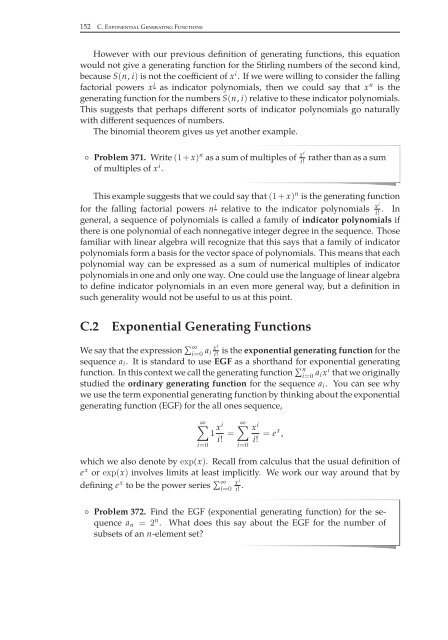Combinatorics Through Guided Discovery, 2004a
Combinatorics Through Guided Discovery, 2004a
Combinatorics Through Guided Discovery, 2004a
You also want an ePaper? Increase the reach of your titles
YUMPU automatically turns print PDFs into web optimized ePapers that Google loves.
152 C. Exponential Generating Functions<br />
However with our previous definition of generating functions, this equation<br />
would not give a generating function for the Stirling numbers of the second kind,<br />
because S(n, i) is not the coefficient of x i . If we were willing to consider the falling<br />
factorial powers x i as indicator polynomials, then we could say that x n is the<br />
generating function for the numbers S(n, i) relative to these indicator polynomials.<br />
This suggests that perhaps different sorts of indicator polynomials go naturally<br />
with different sequences of numbers.<br />
The binomial theorem gives us yet another example.<br />
◦ Problem 371. Write (1+ x) n as a sum of multiples of xi<br />
i!<br />
of multiples of x i .<br />
rather than as a sum<br />
This example suggests that we could say that (1 + x) n is the generating function<br />
for the falling factorial powers n i relative to the indicator polynomials xi<br />
i! . In<br />
general, a sequence of polynomials is called a family of indicator polynomials if<br />
there is one polynomial of each nonnegative integer degree in the sequence. Those<br />
familiar with linear algebra will recognize that this says that a family of indicator<br />
polynomials form a basis for the vector space of polynomials. This means that each<br />
polynomial way can be expressed as a sum of numerical multiples of indicator<br />
polynomials in one and only one way. One could use the language of linear algebra<br />
to define indicator polynomials in an even more general way, but a definition in<br />
such generality would not be useful to us at this point.<br />
C.2 Exponential Generating Functions<br />
We say that the expression ∑ ∞<br />
i=0 a i xi<br />
i!<br />
is the exponential generating function for the<br />
sequence a i . It is standard to use EGF as a shorthand for exponential generating<br />
function. In this context we call the generating function ∑ n<br />
i=0 a ix i that we originally<br />
studied the ordinary generating function for the sequence a i . You can see why<br />
we use the term exponential generating function by thinking about the exponential<br />
generating function (EGF) for the all ones sequence,<br />
∞∑<br />
i=0<br />
1 xi<br />
i! = ∞∑<br />
i=0<br />
x i<br />
i! = e x ,<br />
which we also denote by (x). Recall from calculus that the usual definition of<br />
e x or (x) involves limits at least implicitly. We work our way around that by<br />
defining e x to be the power series ∑ ∞<br />
i=0 xi<br />
i! .<br />
Problem 372.<br />
◦ Find the EGF (exponential generating function) for the sequence<br />
a n = 2 n . What does this say about the EGF for the number of<br />
subsets of an n-element set?


















